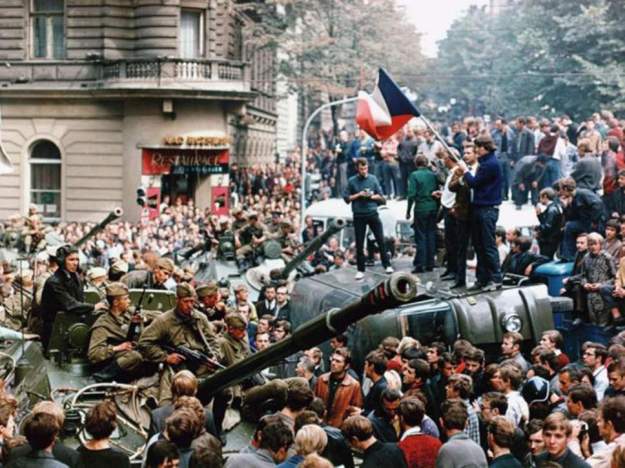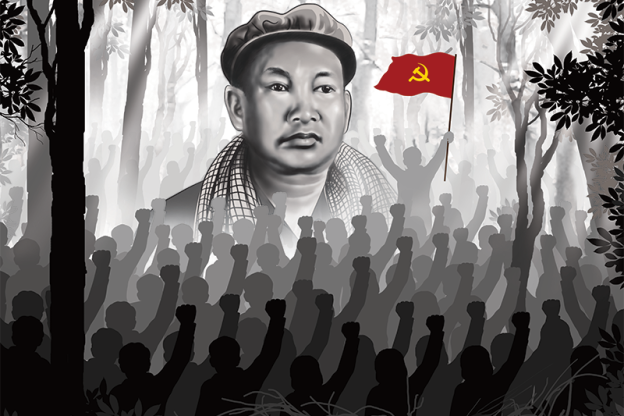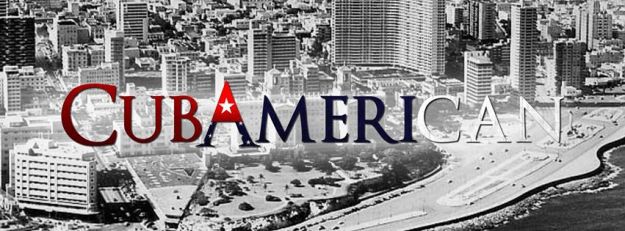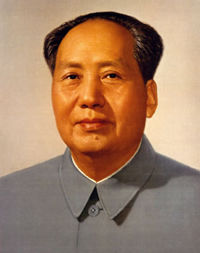Continuing my research on the communist development in Czechoslovakia, I explored the deterioration of the national economy under Communism, emergence of reform movements, and a period of democratization that led to the final dissolution of the Czechoslovak Confederation.
A Deteriorating Economy and The Prague Spring
Acute economic problems emerged from fields of industry and agriculture by the 1960s. Industrially, the prices of goods remained high, while the supply fell short and the quality of goods declined. In addition, production from the collectivized farms started to fall, producing less in 1960 than that was produced even in the prewar era (“Czech”).
This deterioration in the 1960s led to some limited reforms.
- A group of reformers promoted for economic reforms
- Attempted to replace the command economy with a mixed economy (“Czechoslovakia”).
- Introduced marketing principles to agriculture
- But most of these reforms stayed as vague aspirations and lacked implementation (“Czech”).
As these reforms failed, leadership was passed to the Slovak first secretary Alexander Dubček, in January 1968.

President Alexander Dubček
- Dubček took on the role of the nation’s chief reformer, yet himself we not well qualified for this role. He was a Slovak and raised outside of the party apparatus (“Czech”).
- This period of liberation was known as the Prague Spring.
-
- One of the most influential reform emerged with the achievements of the Action Program adopted by this new reformist government, which was adopted in April of 1968.
- This program promoted ideas from preceding years that were unrealized, including overdue economic and agricultural reforms, the democratization of Czechoslovak political life, the transformation of Slovakia into a full parity within the Czechoslovak federation, a revised constitution that would ensure a complete rehabilitation of citizens’ rights that had been infringed in the past years.
- In addition, the program also aimed for a division of powers. The National Assembly, rather than solely the Communist Party would be in control of the government, courts were aimed to become independent and act as mediators between the legislative and executive branches. Although the shared powers between the government and other non-governmental organizations (Political pluralism) was not recommended, the Communist Party would still have to justify its role and compete for authority with these organizations (“Czech”).
- Dubček instituted program was known as “socialism with a human face” and encouraged non-Communists to also participate in the government and restored a number of civil liberties (“Czechoslovakia”).
- The results of this liberalization movement were viewed as unprecedented by the international community. Many Christian churches, national minority associations, and groups advocating for human rights re-emerged as active components of the nation’s society.

Leaders Meeting in Poland for The Warsaw Pact
- But the Soviet Union and other allies in the Warsaw Pact were more alarmed of Czechoslovakia’s shift to democracy. (The Warsaw Pact established a mutual-defense organization during Cold War that mainly involved the Soviet Union, Albania, Bulgaria, Czechoslovakia, East Germany, Hungary, Poland, and Romania; and ensured the maintenance of Soviet military forces on these territories.)
- After Dubček refused to participate in the meeting of the Warsaw Pact powers, the allies sent a letter to Dubček warning that Czechoslovakia was on the verge of counterrevolution. But Dubček remained confident that he would be able to negotiate with the Soviets and resolve the conflicts.
- However, Soviet armed forces invaded Czechoslovakia in August of 1968 and sent Dubček and several of the nation’s leaders to Moscow (“Czech”).

Soviet tanks arrive to crush the Prague Spring
- Dubček witnessed his reforms to regress as the country was restored with “Soviet-bloc norms” under the reign of the communists (“Czechoslovakia”).
- Dubček returned to Prague and noted the people of the prices they had to pay for his reformist program, and agreed with the Soviets to tighten controls over activities within the political and cultural spheres (“Czech”).
- The communist leaders dominating the state focused on improving the productivity of the state-run economy and stifling internal opposition.
- Husák replaced Dubček, became the nation’s first secretary and then the nation’s president, and promoted his program of “Normalization” (“Czechoslovakia”).
- Husák at first wanted to persuade the Soviets that Czechoslovakia would still remain a loyal member, allowing the Soviets to intervene if socialism seemed to be at threat in Czechoslovakia, and repudiating the emergence of Prague Spring.
- Under Husák’s program, purges were carried out an important infrastructure improvement projects (“Czech”).
- Therefore Czechoslovakia during the 70s and 80s became one of the more prosperous yet repressive countries in eastern Europe.
I also found an article that offers us with detailed accounts from young Czechoslovakians on the aftermath of the Prague Spring and their understanding of freedom based on their experience during this era of reform. According to this piece, the Soviet invasion of Czechoslovakia brought forth a repressive era against supporters of the 1968 reforms. For instance, many of those who participated in the reforms lost their jobs and worked under the stringent supervision of the Communist Party.
Democratization and Dissolution

The Velvet Divorce
1989, a wave of democratization “swept across eastern Europe”, encouraged by the leader of Soviet Union, Mikhail Gorbachev.
- The Polish Solidarity movement, the enactment of a democratic constitution in Hungary, and an exodus of East Germans who desired freedom spurred a series of movements against communist rule.
- This caused the communist leadership and policies in Czechoslovakia to be challenged by mass demonstrations in Prague, this nationwide movement later became to be known as the Velvet Revolution.
- In December, the Communists established a coalition government with non-Communists opposition groups.
- This shaped Czechoslovakia to adopt a multiparty political system and Václav Havel became the country’s new president, who promoted free elections to the Federal Assembly in June 1990, with non-Communists winning resounding majorities (“Czechoslovakia”).
- Havel’s government became vital in the transition of Czechoslovakia’s government from communism to democracy.
- He privatized businesses, adjusted the nation’s foreign policy, and wrote a new constitution.
- Soviet troops were removed in June of 1991, and the Warsaw Pact was disbanded a month later (“Czech”).
- This “reemergence of” a multiparty democracy was later known as the Velvet Revolution.
As the communist rule gradually ended and democracy began to surface, the tension between the two portions of Czechoslovakia intensified.
- Slovaks opposed Czechs’ preference of state-run industries and the privatization of the nation’s goods (“Czechoslovakia”).
- The re-writing of the constitution was hindered by the differences between political parties of each side, an agreement was hard to be achieved on a federal level. In addition, as minorities, the Slovak deputies were granted a disproportionate veto power (“Czech”).
- The election in June of 1992 highlighted the tension and disagreements among them(“Czechoslovakia”).
- The Czechoslovak federation began to appear as fragile and separatism rose as an important issue (“Czech”)
- Talks later in the year of 1992 between leaders from both sides “resulted in the peaceful dissolution of Czechoslovakia.
- This was also part of the “Velvet Divorce” as two new countries were created the Czech Republic and Slovakia on Jan.1.1993, ending the 74-year of joint existence (“Czechoslovakia”).
As the national economy began to regress under the communist rule, a period of reforms emerged. It is interesting to learn the development of the reform movements and understand how repercussions of earlier reforms influenced the scheme of the following reform programs. It also surprised me that Czechoslovakia endured so many subversive changes within only 50 years, experiencing the Prague Spring, the invasion of the Soviets, a challenging transformation back into an oppressive communist rule, a wave of democratization, and the dissolution. Communism in Czechoslovakia also altered and adapted different forms as the nation developed.
Works Cited
Sources
“Czech and Slovak History.” Bulgaria, Hungary, Romania, the Czech Republic, and Slovakia, edited by Lorraine Murray, Chicago, Britannica Educational Publishing with Rosen Educational Services, 2014, pp. [283]-347. The Britannica Guide to Countries of the European Union. Gale Virtual Reference Library, link.galegroup.com/apps/doc/CX3807400030/GVRL?u=west66701&sid=GVRL&xid=1f5c7f55. Accessed 7 Apr. 2019.
“Czechoslovakia.” Britannica School, Encyclopædia Britannica, 26 Sep. 2018. school.eb.com/levels/high/article/Czechoslovakia/28462. Accessed 7 Apr. 2019.
“Life in Communist Czechoslovakia: Voices of Youth: A USCSAR Symposium.” Eurasiacenter, eurasiacenter.org/archive/1990-1999/1991lifeincommunistczech.htm. Accessed 22 Apr. 2019.
Images:
Getty Images. Leaders Meeting in Poland for The Warsaw Pact. 1955. Independent, http://www.independent.co.uk/news/long_reads/prague-spring-anniversary-czechoslovakia-soviet-union-wwii-czech-republic-slovakia-a8485326.html. Accessed 22 Apr. 2019.
—. President Alexander Dubcek. Otago Daily Times, Copyright Allied Press Limited 2019, http://www.odt.co.nz/entertainment/books/historical-homework-means-cold-war-tale-rings-true. Accessed 22 Apr. 2019.
—. Soviet tanks arrive to crush the Prague Spring. Independent, http://www.independent.co.uk/news/long_reads/prague-spring-anniversary-czechoslovakia-soviet-union-wwii-czech-republic-slovakia-a8485326.html. Accessed 22 Apr. 2019.
The Velvet Divorce. Worldatlas, 2019 worldatlas.com, http://www.worldatlas.com/articles/what-was-the-velvet-divorce.html. Accessed 22 Apr. 2019.






 The founder of Marxism is the German Philosopher, Karl Marx, who belonged to the larger group of Western thinkers that brought new, secularized solutions to questions regarding the human prospects. Inspired to initiate progressive changes pertaining to issues within institutions in Germany, Marx was determined to pursue his path in the field of philosophy. While working as a journalist in Paris, a center of European radicalism, Marx began his critique on the revolutionary history of France. He soon discovered the “agent” of revolutionary change that was subjected to economic oppression at the time–the proletariat(working class). Due to the private-property-based economy, workers were unable to achieve satisfaction or attain self-development. Marx criticized this alienation of workers’ products and their producers(
The founder of Marxism is the German Philosopher, Karl Marx, who belonged to the larger group of Western thinkers that brought new, secularized solutions to questions regarding the human prospects. Inspired to initiate progressive changes pertaining to issues within institutions in Germany, Marx was determined to pursue his path in the field of philosophy. While working as a journalist in Paris, a center of European radicalism, Marx began his critique on the revolutionary history of France. He soon discovered the “agent” of revolutionary change that was subjected to economic oppression at the time–the proletariat(working class). Due to the private-property-based economy, workers were unable to achieve satisfaction or attain self-development. Marx criticized this alienation of workers’ products and their producers(

 Another expression of Marxist ideology is Maoism, which is a broad term that includes Mao Zedong’s ideologies, political philosophy, and vision towards party leadership in China. Born in a peasant family, Mao was intrigued by tales of rebelling peasants against exploitative middle class and bureaucracy. He became a leading force in rejecting the old Confucian norms of the society which were based on set of social relationships that placed high value on age and order. As Mao witnessed the deterioration of Chinese society under Japanese incursions, he joined the Chinese Communist Party(CCP) during his time in Peking University. His northern expedition and defeat of militarist leaders earned Mao a prominent role in the party. Ambitious Mao adopted series of strategies such as mass mobilization, the Great Leap Forward, and the Cultural Revolution. Mao’s emphasis on upholding the peasant class as the driving force of revolution distinguished Maoism from ideologies of Marxism-Leninism that believed in the strength of the urban proletariat. His personal background, China’s historical context, and Mao’s charisma with his tactics of promoting his theory shaped Maoism.
Another expression of Marxist ideology is Maoism, which is a broad term that includes Mao Zedong’s ideologies, political philosophy, and vision towards party leadership in China. Born in a peasant family, Mao was intrigued by tales of rebelling peasants against exploitative middle class and bureaucracy. He became a leading force in rejecting the old Confucian norms of the society which were based on set of social relationships that placed high value on age and order. As Mao witnessed the deterioration of Chinese society under Japanese incursions, he joined the Chinese Communist Party(CCP) during his time in Peking University. His northern expedition and defeat of militarist leaders earned Mao a prominent role in the party. Ambitious Mao adopted series of strategies such as mass mobilization, the Great Leap Forward, and the Cultural Revolution. Mao’s emphasis on upholding the peasant class as the driving force of revolution distinguished Maoism from ideologies of Marxism-Leninism that believed in the strength of the urban proletariat. His personal background, China’s historical context, and Mao’s charisma with his tactics of promoting his theory shaped Maoism. My inspiration for this independent study came from my last year’s classes. In the first semester of
My inspiration for this independent study came from my last year’s classes. In the first semester of